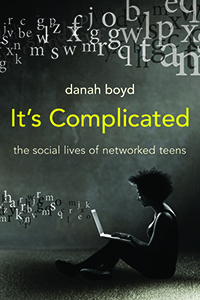Vicky Kelman
 Well, it is complicated….but maybe not as much as we feared.
Well, it is complicated….but maybe not as much as we feared.
An addiction?
danah boyd (she prefers her name to be fully in lower-case letters) is optimistic about the value of social networking in the lives of teens. Her research tells her that teens are not addicted to their phones and computers (as we often assume they are) …they are addicted to their friends (as teens have always been). Devices are best seen as tools in support of that addiction.
This insight was a big “aha” for me…and actually left me less concerned about the impact of technology on teens’ lives and habits. Boyd’s faith in teens and technology is infectious. She makes a good case for adults to step back and relax when dealing with this aspect of teen life. As she points out “The language of addiction sensationalizes teens’ engagement with technology and suggests that mere participation leads to pathology. “ ( ch. 3 ) “Teens turn to and are obsessed with, whichever environment allows them to connect to friends. Most teens aren’t addicted to social media; if anything they ‘re addicted to each other.” (ch 3)
 As boyd sees it, this generation of teens has less direct face-to-face access to their friends than previous generations did. Teens are not attending neighborhood schools (they are in private schools, or magnet schools, charter schools well beyond their neighborhoods); public transportation is poor or non-existent or not considered safe (by parents); teens’ after school time is booked up with athletics, volunteer activities, after school drama or music; SAT tutoring. Working parents are wary of having unsupervised teens home alone with friends. There is no more mall to hang out at or neighborhood “soda fountain” or even a safe outdoor space where group walking home from school together can hang out. Where can they meet ? On line! For teens, “social acceptance depends on the ability to socialize with one’s peers at the “cool” place. Each cohort of teens has a different space that it decides is cool. “ (introduction) Twitter and Instagram and Snapchat are the current cool places (although this evolves [and probably is as I write this]).
As boyd sees it, this generation of teens has less direct face-to-face access to their friends than previous generations did. Teens are not attending neighborhood schools (they are in private schools, or magnet schools, charter schools well beyond their neighborhoods); public transportation is poor or non-existent or not considered safe (by parents); teens’ after school time is booked up with athletics, volunteer activities, after school drama or music; SAT tutoring. Working parents are wary of having unsupervised teens home alone with friends. There is no more mall to hang out at or neighborhood “soda fountain” or even a safe outdoor space where group walking home from school together can hang out. Where can they meet ? On line! For teens, “social acceptance depends on the ability to socialize with one’s peers at the “cool” place. Each cohort of teens has a different space that it decides is cool. “ (introduction) Twitter and Instagram and Snapchat are the current cool places (although this evolves [and probably is as I write this]).
boyd is very clear that most teens would opt for being in the same room and face-to-face with friends if only they could. She describes a high school football game she attended as part of her research, which looked , to her, exactly like the ones she herself attended as a high school student in terms of what students were doing, how they were socializing and hanging out. They used their devices to find each other and after that seemed to ignore them (except to share something of interest with a friend). To boyd, it seemed it was the parents in attendance who were paying much more attention to their phones.
danah boyd also believes that teens, aching to get out into the real world, use the internet for that purpose, too. As noted above, their mobility is limited. Their window into that big world is the internet. They can break out through that window to see what the world is really like. “ They are struggling to carve out an identity that is not defined solely by family ties.” (introduction)
Parents’ worries:
In the same way that teens have always sought the cool place to hang out with friends, parents have always worried about the impact of the latest fad or technology on the lives of the next generation. Boyd calls these “moral panics” and you will recognize many from your own experience or from what you have heard from your own parents whether it was the Charleston, or the telephone or rock and roll or Elvis in particular; comic books or Mad Magazine, television, rap—were all seen in their times as corrupting teens. Boyd puts many of the fears around social networking in this same basket of ‘things parents worried about that we laugh about now.’ She makes a good case.
In addition, the parental “moral panics” around safety, specifically around sexual predators and bullying just don’t pan out to be real dangers.
- “ … internet- initiated sexual assaults are rare. The overall number of sex crimes against minors has been steadily declining since 1992, which suggests that the internet is not creating a new plague.” (ch. 4)
- There is not more bullying—but bullying does have a wider audience which means that more people are aware of bullying when it does occur. Mean texts and tweets travel further than a nasty comment whispered in the school hallway. It is harder for the victim to escape the long arm of the online community but bullying itself does not seem to be more prevalent.
That being said, boyd makes the point it remains important to keep eyes on what kids are doing on line and where they are spending time. There are kids who are vulnerable and it is important for parents and teachers to know who those kids are and to keep an eye on the kids who may be struggling. Teens who are most at risk on line are often struggling everywhere. (ch 4) boyd found that teens who are getting into trouble on line were not those hanging out with friends but rather those using social networks to meet strangers. “There is a strong correlation between risky online practices and psychosocial problems, family issues, drug and alcohol abuse and trouble in school.” (ch 4)
Lingering Questions
boyd makes a very good case for a more “chill” approach to the whole world of teens and social networks. However—I do think there are still concerns that linger and call out for some attention and exploration.
I’d like to know how the reliance on devices impacts adolescents’ social and communication skills when they are “off-line.” Youth group , summer camp, small project based groups in school—do they talk? Do they listen? Can they look another person in the eye? And how and where will they learn that? Do youth leaders and camp counselors themselves (older members of the same generation) possess the skills and values to develop the face-to-face skills. Have our summer camps (the most intense peer group experience most kids have) found that campers and staff have deficits in this area or need support? Is anyone paying attention?
In contrast to the story of the college kid texting her roommate (who is sitting in the room) to tell her that she needs to get her dirty laundry off the floor …do they go off to college equipped with the people skills to talk with a roommate when there is a problem, ask someone out or break-up with a face-to-face conversation, leave their smart phone in their pocket or turn it off when attending a meeting or going for a job interview? Or is none of that important?
Parents tell me they worry the most about their kids texting while driving. Addiction to friends not devices is a helpful insight from boyd, but doesn’t that addiction still constitute a (dangerous) distraction ?
In an article in Slate about a fading of a staple of American high school culture, the school dance, one assistant principal who was interviewed said, “Lucy told me that the reason students didn’t attend [the dance] was because everyone would rather be home texting, facebook messaging, or Snapchatting each other…Kids don’t need to go to a dance to interact with each other when they can sit in the bed with their laptop and phone and text them. It’s basically like being with that person. You don’t have to show up to a dance hoping to see someone anymore. You can literally Snapchat them and see them on Snapchat.” (Slate, pinkunicorn, originally appeared in Business Insider)
“It’s basically like being with that person???” Now, that’s scary!

